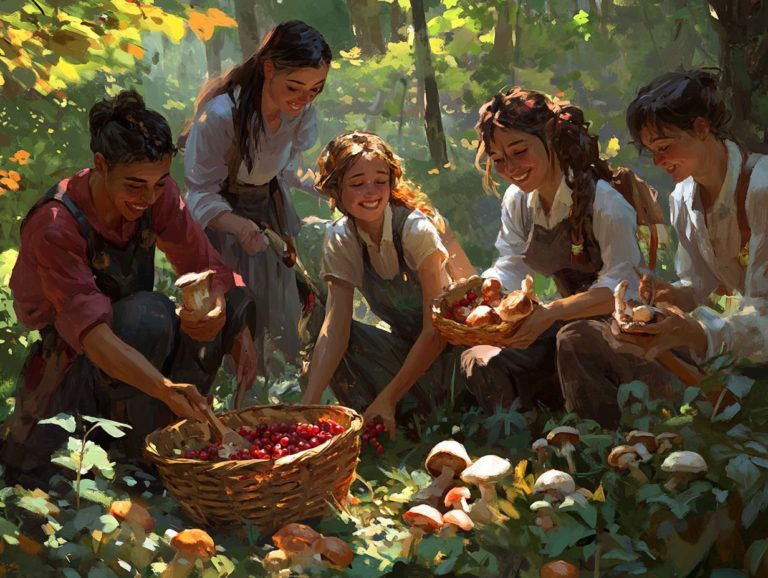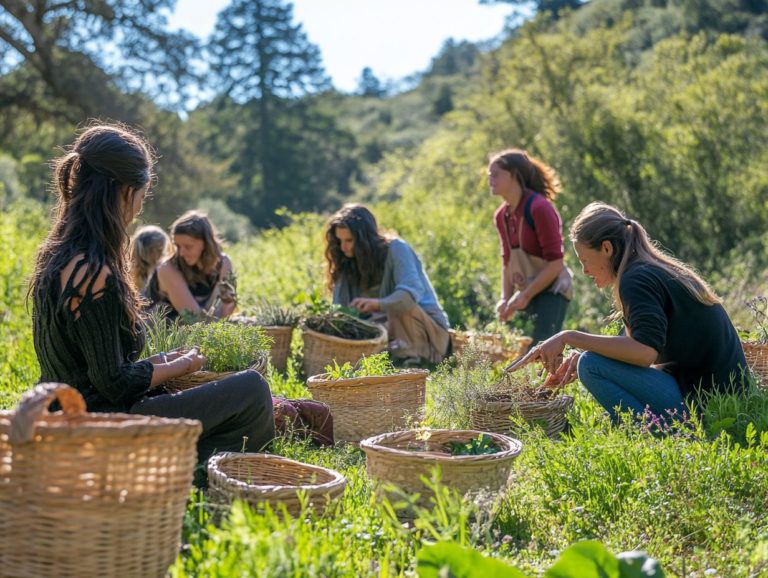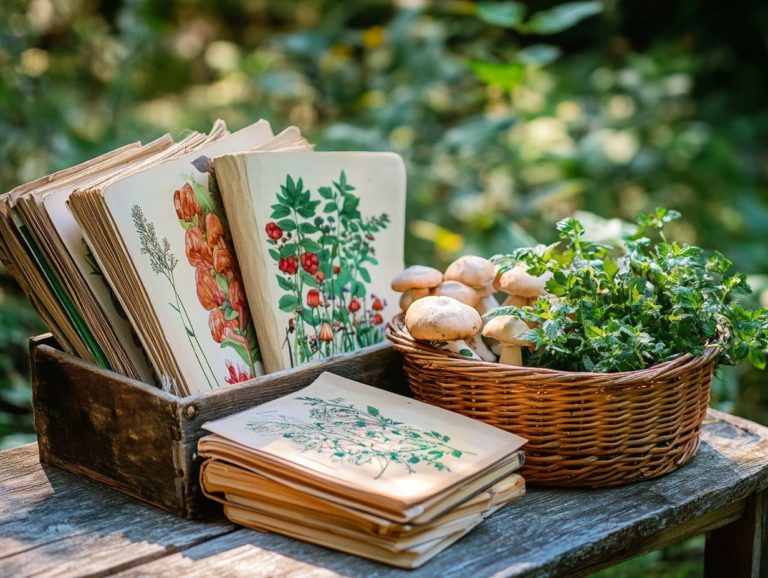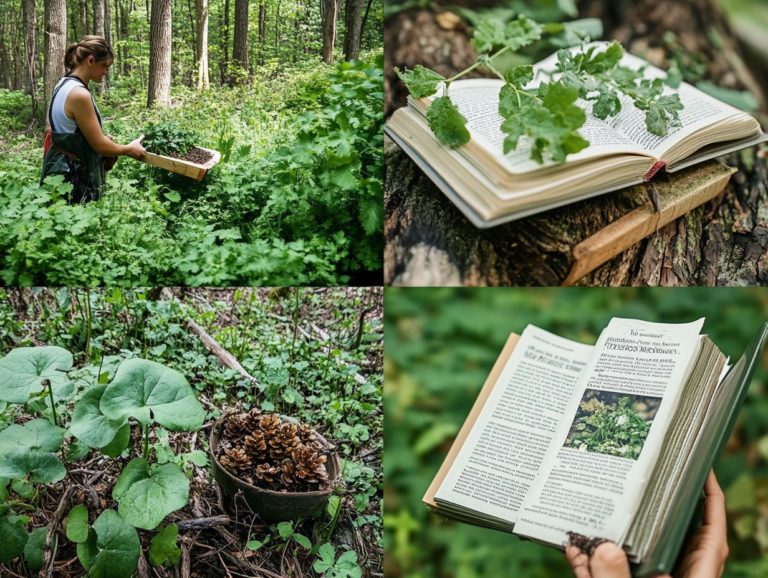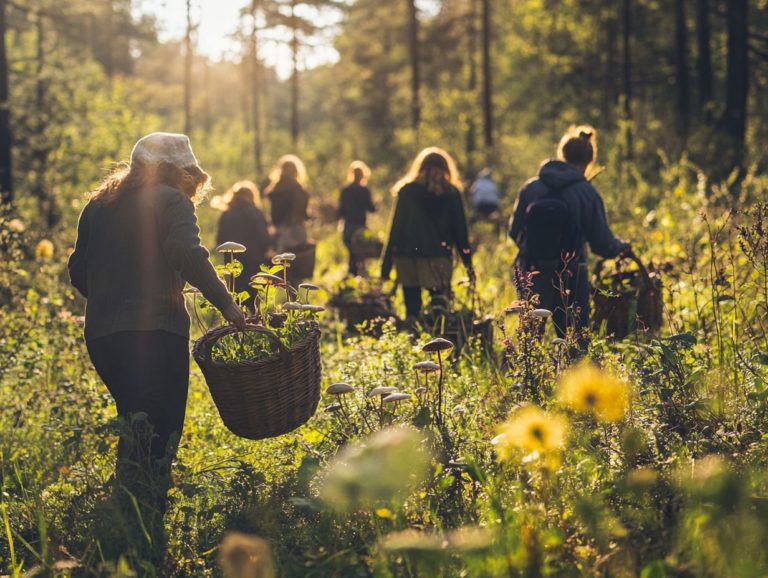5 Strategies for Community Foraging Education
Foraging transcends mere trendiness; it serves as a meaningful way for you to reconnect with nature and embrace a lifestyle rooted in sustainability.
This article delves into five essential strategies for educating your community about foraging. It expertly guides you through the basics of identifying safe, edible plants and employing sustainable techniques.
Discover exciting ways to add foraged foods to your meals today! Recognize the vital role of knowledge-sharing within your community.
Addressing common misconceptions and potential risks ensures that you are fully prepared for a rewarding foraging experience.
Embrace the opportunity to uncover the numerous benefits for both yourself and the environment!
Contents
- Key Takeaways:
- 1. Understanding the Basics of Foraging
- 2. Identifying Safe and Edible Plants
- 3. Practicing Sustainable Foraging Techniques
- 4. Incorporating Foraged Foods into Everyday Meals
- 5. Sharing Knowledge and Resources within the Community
- Why Is Community Foraging Education Important?
- What Are the Benefits of Foraging for Individuals and Communities?
- How Can Foraging Promote Sustainability and Environmental Awareness?
- What Are the Potential Risks and Safety Precautions of Foraging?
- What Are Some Common Misconceptions About Foraging?
- How Can Communities Encourage and Support Foraging Education?
- Frequently Asked Questions
- What are the benefits of community foraging education?
- How can I get involved in community foraging education?
- What are some important safety measures to keep in mind during community foraging?
- How can I incorporate foraging education into my community garden or farm?
- What are some sustainable foraging practices to keep in mind?
- Can children participate in community foraging education?
Key Takeaways:
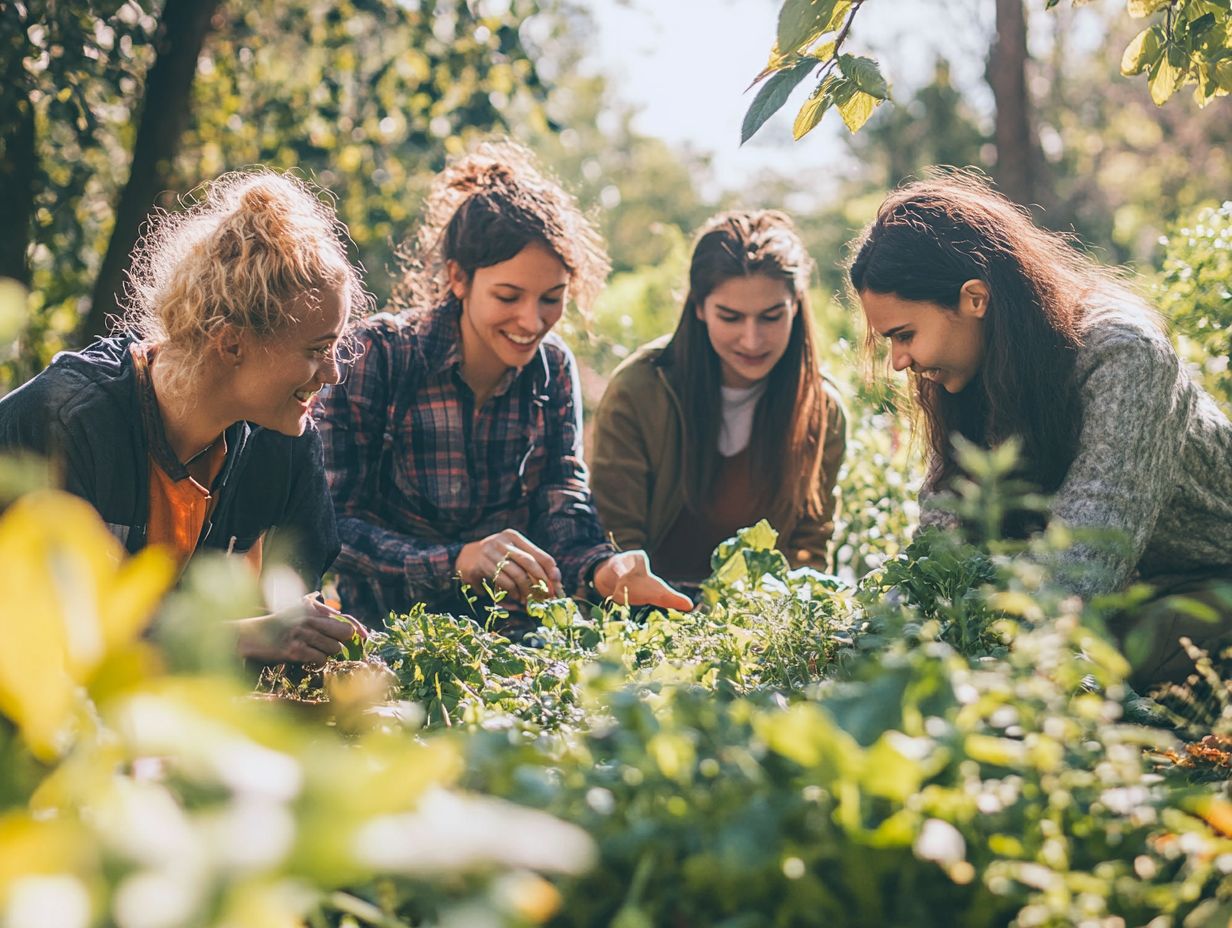
Here are some key takeaways to keep in mind:
- Understand the basics of foraging to safely and sustainably gather wild foods.
- Identify and differentiate between safe and edible plants to avoid potential risks while foraging.
- Incorporate foraged foods into everyday meals for a more sustainable and diverse diet.
1. Understanding the Basics of Foraging
Foraging is the art of gathering wild food from nature. This skill connects you to your local environment and enhances your understanding of edible plants. It fosters a deep appreciation for the ecological balance surrounding you.
This thrilling pursuit invites you into the realm of wild foods, from fragrant wild garlic to luscious blackberries, while also introducing you to herbalism and sustainable harvesting techniques.
Engaging in foraging can be a transformative journey. It encourages community involvement and immersion in the natural world, enriching the learning experience for both novices and seasoned wild crafters. To ensure a rewarding experience, consider following the top 5 tips for successful foraging.
By diving into hands-on activities, you can build confidence as you explore local plants, their seasonal availability, and the unique flavors they bring. Enrolling in local herbal courses can elevate this experience, offering insightful lessons from seasoned foragers who impart practical skills alongside the principles of ecological stewardship.
This collective engagement nurtures a sense of responsibility towards nature. It underscores how foraging plays a vital role in maintaining biodiversity and sustainability. Connecting with others through shared experiences can lead to lasting friendships, weaving a strong community fabric rooted in nature and food, further emphasizing the profound relationship between humans and the earth.
2. Identifying Safe and Edible Plants
Identifying safe and edible plants is a fundamental skill in foraging. It allows you to savor the abundance of your local wild plant community while steering clear of toxic species and potential health risks.
This skill deepens your appreciation for nature and promotes a sustainable way of eating. When you venture into the world of wild mushrooms, it s essential to distinguish between the edible varieties and their toxic counterparts, which can often look quite similar.
Likewise, common plants like dandelions are not just safe; they re packed with nutrients and offer a multitude of benefits.
To embark on this foraging adventure safely, always carry a first aid kit. Even the most seasoned foragers can encounter the unexpected. Familiarizing yourself with local flora, understanding seasonal changes, and consulting trustworthy guides can greatly enhance your ability to identify both edible and poisonous plants, ensuring you have a safe and rewarding foraging experience.
3. Practicing Sustainable Foraging Techniques
Practicing sustainable foraging techniques is essential for maintaining ecological balance. This ensures that food systems remain resilient and diverse for generations to come.
By selectively gathering edible plants and fungi, you actively contribute to a healthier environment while honoring the growth cycles of these vital resources. Following foraging guidelines helps you mitigate the impacts of invasive species, which can overwhelm local ecosystems and disrupt native biodiversity.
As a responsible forager, you not only educate others about the importance of ethical practices but also cultivate a community that values ecological health. In this way, your informed foraging efforts enhance your personal well-being while playing a crucial role in preserving the integrity of local habitats.
4. Incorporating Foraged Foods into Everyday Meals
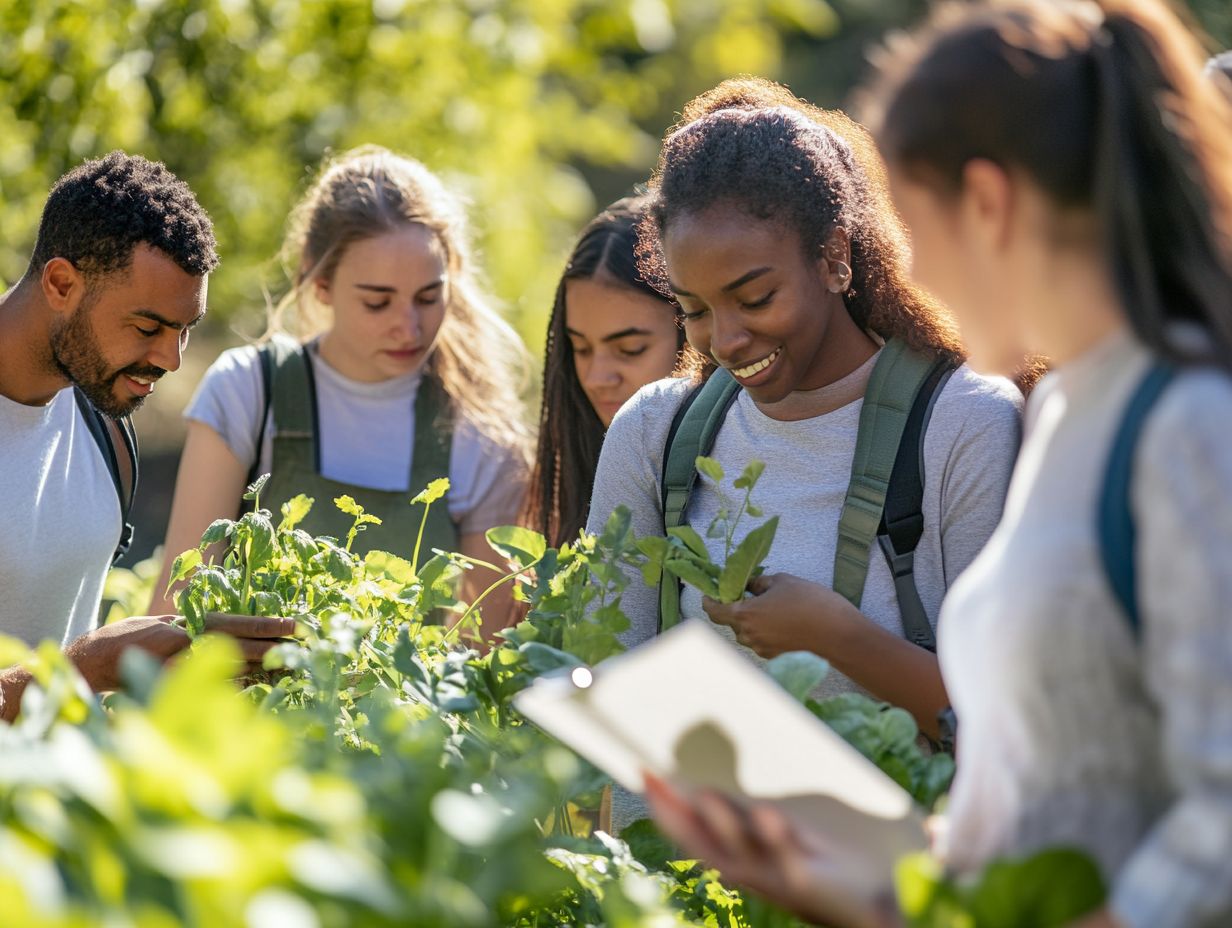
Incorporating foraged foods into your everyday meals not only enriches your diet. It also sparks creativity in the kitchen and deepens your appreciation for the seasonal gifts nature has to offer.
When you experiment with wild ingredients, you can turn simple dishes into extraordinary cooking experiences. This invites you to explore new flavors and textures. Whether you re discovering wild garlic in a nearby woods or picking fresh berries from a local shrub, each foraged find adds a unique twist to your familiar recipes.
Encouraging community dialogue around these ingredients enhances shared experiences. It allows everyone to learn and grow in their foraging journeys. By exchanging tips and personal discoveries, you cultivate a deeper connection with nature while celebrating the art of cooking. This helps ground your meals in the rhythm of the changing seasons.
5. Sharing Knowledge and Resources within the Community
Sharing knowledge and resources within your community is essential for creating a lively foraging community. It enables you to learn from one another and exchange valuable tips, including essential foraging skills for everyone.
This collective engagement enhances your understanding of local ecosystems. It also fosters a profound sense of belonging and stewardship for the environment. Participating in workshops led by environmental educators or experienced wild crafters introduces you to safe foraging practices. This equips you with the skills to properly identify edible plants and mushrooms.
Local events, such as community seed swaps and foraging walks, provide you with tangible experiences. These elevate theoretical knowledge and transform it into practical application. Through these interactions, you can cultivate lasting connections and become part of a vibrant network committed to preserving and sharing the rich bounty of nature.
Why Is Community Foraging Education Important?
Community foraging education is vital because it cultivates a shared understanding of local food resources. Learning how to build a foraging community promotes social habits focused on sustainability and deepens your connection to the environment.
Engaging in hands-on experiences creates a platform for knowledge sharing. This enables both experienced foragers and newcomers to swap insights about the seasonal availability of edible plants and their various uses.
This collaborative learning environment enhances your skills and nurtures lasting friendships. It weaves a stronger fabric within the community. Environmental educators play an instrumental role in this journey. They lead workshops and field trips that showcase the importance of local food systems and the variety of different plants and animals in an area.
Through community programs, you become more aware of sustainable practices. This helps you appreciate the significance of stewardship and the transformative effects that foraging can have on both personal and communal well-being.
What Are the Benefits of Foraging for Individuals and Communities?
Foraging presents a wealth of benefits, not just for you as an individual but for communities as a whole. It encourages healthier eating habits and deepens your connection with nature. Additionally, it allows you to explore a wild food landscape often without spending a dime.
By embracing this timeless practice, you can enrich your diet with nutritious, often organic ingredients. You’ll also look into the powerful world of herbal medicine. This natural approach to health can significantly enhance your well-being, helping you alleviate ailments and elevate your overall vitality.
From an economic standpoint, foraging serves as a savvy way to supplement your grocery budget. This is especially helpful if you re part of a family aiming to eat well without breaking the bank. On a community level, engaging in shared foraging activities strengthens social bonds and cultivates networks of knowledge.
Ultimately, gathering food from nature fosters a deeper sense of stewardship and connection to the environment. Don’t miss out on the chance to enrich your meals with fresh, wild ingredients!
How Can Foraging Promote Sustainability and Environmental Awareness?
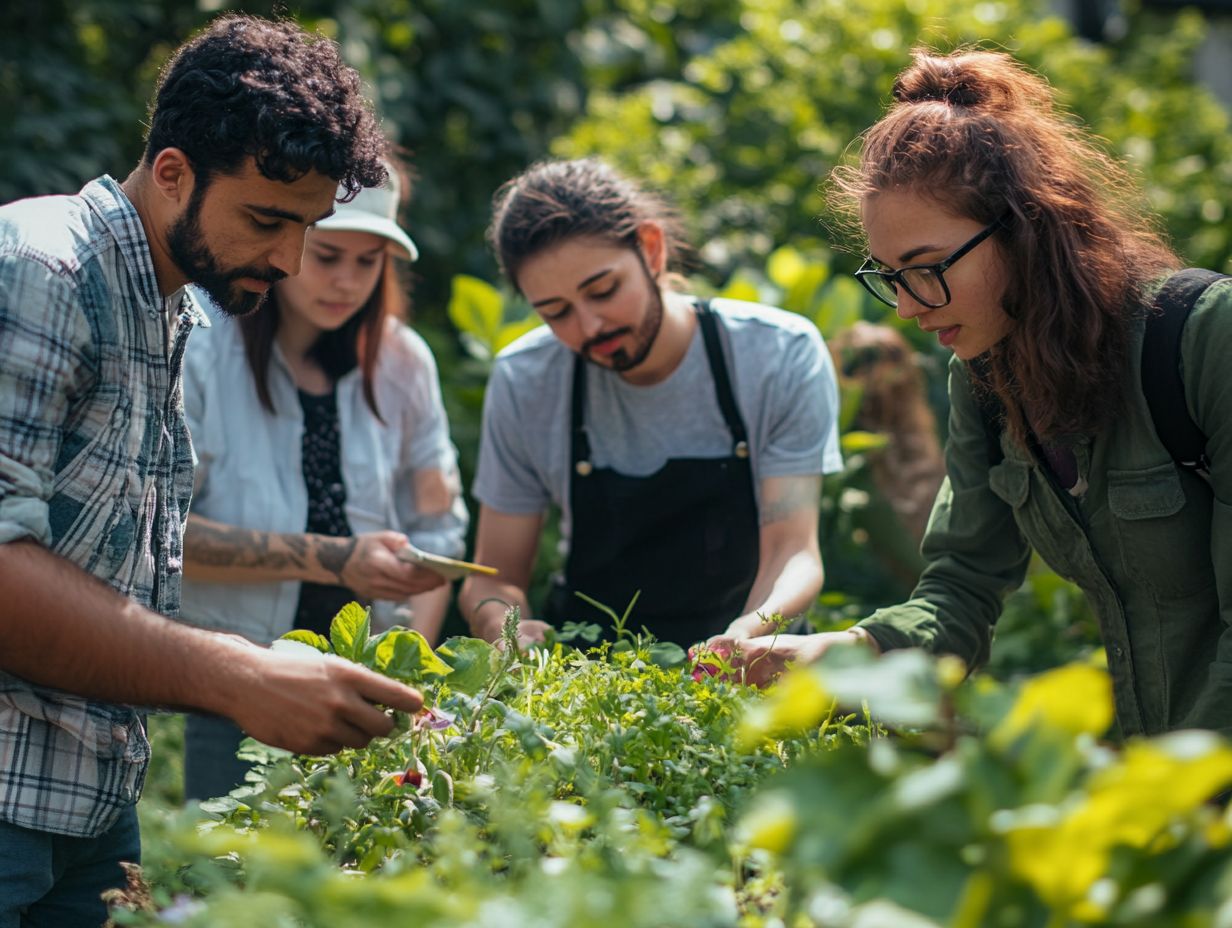
Foraging nurtures sustainability and deepens your environmental awareness by inviting you to engage directly with your local ecosystems. It helps you grasp the significance of the variety of different plants and animals in an area, and you can enhance the experience by learning foraging techniques to engage children while actively participating in the preservation of wild plant communities.
When you step into your nearby woods, fields, or parks in search of edible plants, you often forge a richer connection to the land around you. This hands-on adventure fosters a profound respect for the intricate web of life that flourishes in these natural habitats.
Various initiatives, such as community foraging workshops and guided nature walks, beautifully intertwine the art of foraging with essential environmental education. As you learn to identify native species, you also discover the delicate ecological balance required for thriving ecosystems. Exploring ways to encourage foraging in urban spaces cultivates a sense of stewardship and responsibility, giving you the power to protect these invaluable resources.
What Are the Potential Risks and Safety Precautions of Foraging?
Foraging can be an incredibly rewarding experience, but it s crucial for you to be aware of potential risks and implement safety precautions to protect yourself from toxic plants and other hazards.
Identifying toxic plants is essential for anyone like you venturing into the wild in search of edible flora. Familiarizing yourself with common lookalikes is key, as these could lead to serious health issues. Learning to utilize field guides or mobile apps can significantly enhance your identification skills. Preparedness is paramount; having a well-stocked first-aid kit can truly make a difference in emergencies.
Here are some essential safety tips:
- Team up with an experienced forager!
- Never consume anything unless you are 100% certain of its identity.
- Be on the lookout for potential environmental contaminants in the area.
Responsible foragers like yourself always respect nature by leaving enough plants behind to ensure sustainability for future foragers.
What Are Some Common Misconceptions About Foraging?
Common misconceptions about foraging can lead you astray, creating misunderstandings that it s merely a survival tactic or that every wild food is safe to consume.
In truth, foraging is a complex activity that blends skill, knowledge, and a deep appreciation for nature’s bounty. It transcends the instinct for survival, inviting you into a rich exploration of ecosystems, flavors, and traditions.
You might think that anyone can just wander into the wild and gather food without any training, but that s a risky assumption. Identifying which plants, mushrooms, and berries are safe to eat demands in-depth knowledge and careful study.
By immersing yourself in workshops, consulting guides, or learning from experienced foragers, you can significantly minimize risks while reaping the rewards of this enriching practice. Plus, you ll cultivate a genuine appreciation for sustainable food sources along the way.
How Can Communities Encourage and Support Foraging Education?
Communities have the power to elevate foraging education through engaging initiatives like workshops, guided foraging adventures, and knowledge-sharing platforms that draw you in.
By establishing partnerships with local environmental educators and organizations, these communities can present a more structured approach to foraging. This collaboration enriches your learning experience and can include 5 ways to make foraging a family activity, ensuring you access expert insights and valuable resources.
Offering open-access workshops or hosting community-led gatherings can sharpen your skills while raising awareness about the benefits of sustainable foraging practices.
Creating online forums or local networks can open the floor for discussions, allowing you to share experiences and exchange tips and resources. This not only deepens your connection to nature but also fosters a sense of environmental stewardship that benefits everyone.
Frequently Asked Questions
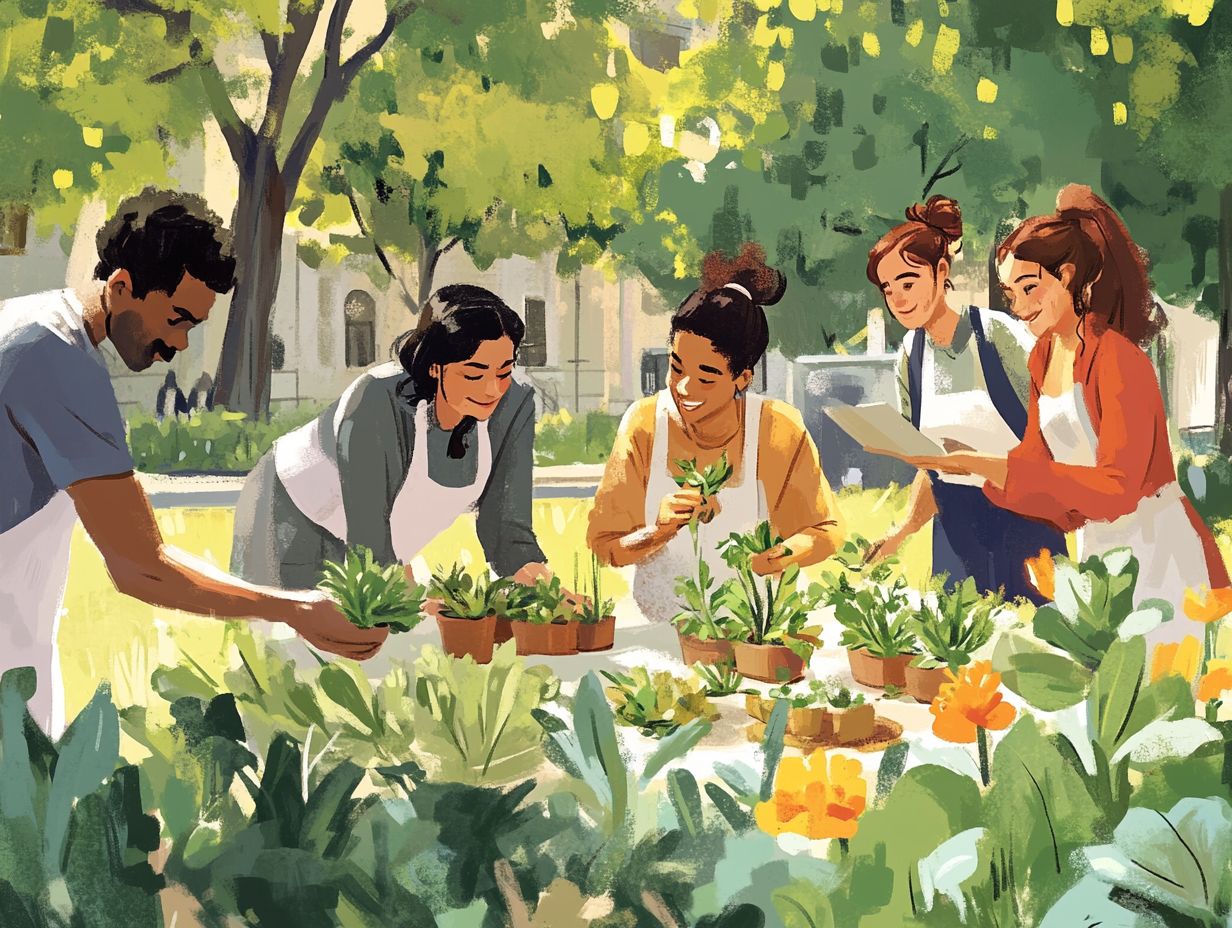
What are the benefits of community foraging education?
Community foraging education boosts sustainability and food security, and learning how to use foraging to educate others also builds a strong sense of community.
How can I get involved in community foraging education?
Join local foraging groups or attend workshops. You can even start your own foraging program!
What are some important safety measures to keep in mind during community foraging?
Always identify plants correctly. Avoid polluted areas and be aware of allergens.
How can I incorporate foraging education into my community garden or farm?
Host workshops and guided foraging walks. Create signs or start a foraging club to share knowledge.
What are some sustainable foraging practices to keep in mind?
Forage in moderation and avoid over-harvesting. Respect the ecosystem and its inhabitants.
Can children participate in community foraging education?
Absolutely! With supervision, children can learn about safety and sustainable practices.


